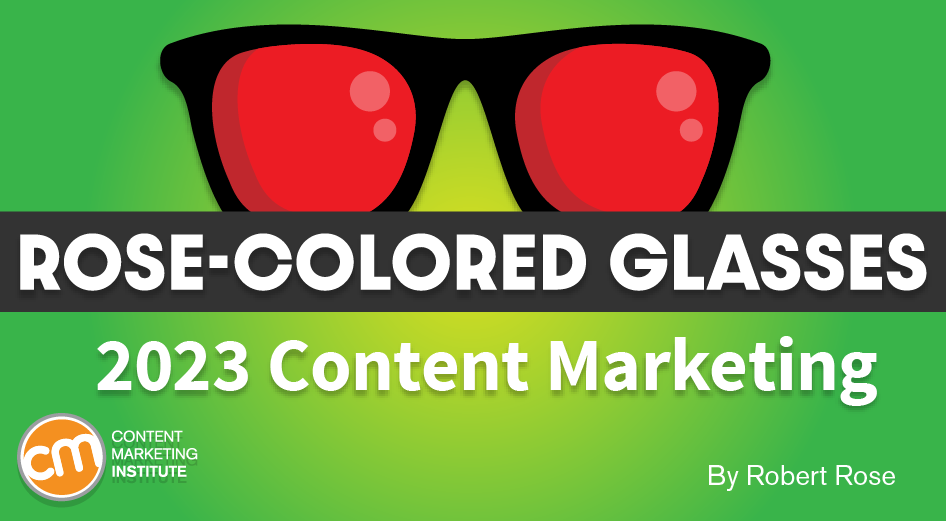MARKETING
State of Content Marketing in 2023

I just pressed send on the manuscript for my book to be released in September. It’s called Content Marketing Strategy (snappy, eh?), and Kogan Page will publish it.
Last week, marketing professor Philip Kotler wrote the foreword. I won’t spoil it, but he mentioned the need for a strategic approach to owned media.
He writes, “(T)he company doesn’t carry an account of showing these marketing assets and their value. As a result, the company cannot show the CEO and company board members a return on owned assets or content.”
Luckily, my upcoming book shows exactly how to do that. Funny how that works out.
In any event, all this struck me that now is an opportune time to look at where the beloved practice of content marketing stands today.
First, let’s go back to 1999 when Kotler published Kotler On Marketing, one of his more than 70 books. The latter 1990s – a time of tumultuous change – fueled most of the thinking for the book. But he knew that it was merely the beginning.
Kotler concluded the book with a section called “Transformational Marketing.” In the next decade, he wrote, “marketing will be re-engineered from A to Z. Marketing will need to rethink fundamentally the processes by which they identify, communicate, and deliver customer value.”
Well, it’s taken over two decades, but it’s finally happening.
Consumers have changed, but marketing operations are just starting to
In case you didn’t notice, almost every marketing conference these days starts with the same four or five requisite slides:
- Digital technologies, such as search and social media, empower consumers today.
- Consumers research, engage, buy, and stay loyal to brands in ways that have fundamentally changed.
- First-party data and privacy are of the utmost importance.
- Artificial intelligence begins to threaten the idea of the usefulness of search and pressure companies to deliver better and more personalized experiences.
You get it. Consumer expectations in the age of the social, mobile, and AI-driven web are different than they were.
However, the continuing challenge in 2023 is that content and/or marketing operations in enterprise companies are only beginning to evolve. Most marketing departments have remained as they were when Kotler wrote his book — they still work from mid- to late-20th century hierarchies, strategies, and processes.
Most marketing departments still work with mid- to late-20th-century hierarchies, strategies, and processes, says @Robert_Rose via @CMIContent. Click To Tweet
Content marketing isn’t new, but a content marketing strategy is
For hundreds of years, businesses have used content to affect some kind of profitable outcome. But the reality is this: Whether it was John Deere’s The Furrow from the 1800s, Michelin’s guide to car maintenance in the early 1900s, or even Hasbro’s GI-Joe partnership with Marvel in the 1980s, content was not — and is not for the most part now — a scalable, repeatable practice within the function of marketing. In short, companies almost always treat content marketing as a project, not a process.
That fundamental change will finally take hold in 2023. It could happen because of the digital disruption and ease by which you can now publish and distribute content to aggregate your own audiences. It could happen through the natural evolution that the ultimate outcome – more than the marketing – matters more.
As we roll through 2023 and beyond, content — and the exponentially increasing quantities of it produced by every organization — deeply affects not just your marketing strategy, but your business strategy. Content in marketing is now bigger than simply content marketing, and it should be dealt with as a component of that business strategy throughout the enterprise.
#Content in marketing is bigger than #ContentMarketing. Treat it as a component of the business strategy, says @Robert_Rose via @CMIContent. Click To Tweet
In 2023, the No. 1 focus of my consulting and advisory practice these days: help companies transform content into a repeatable, scalable, and measurable function that drives value through a multi-channel strategy. It’s bigger than publishing a blog, creating a lead-generating resource center, or sending an email newsletter. Today’s content marketing team is being absorbed into marketing because marketing and its various operations are fundamentally transforming into a content-producing machine.
It is not good enough to produce content “like a media company would.” The goal must be to operate as a media company does. Your job is not to change content to fit new marketing goals. Rather, your job in 2023 is to change marketing to fit the new business content goals.
Your job in 2023 is to change #marketing to fit the new business #content goals, says @Robert_Rose via @CMIContent. Click To Tweet
The unaware builds a case for the aware
The term “content marketing” continues to evolve. Even today, I run across those who still call it “brand publishing,” “custom content,” or “inbound marketing.”
My take matches with what Kotler described in 1999. I always thought the term “content marketing” would become part of “marketing” more broadly. In 2023, that happened. So, returning to the lexiconic debates of 2013, 2014, or 2015 doesn’t seem terribly productive. Content marketing is just good marketing, and marketing is just good content marketing.
That said, two kinds of companies do well at the broader view of content marketing. Some of them, such as Cleveland Clinic, Red Bull, Arrow Electronics, HubSpot, and REI, have purposely devised content marketing strategies as differentiating approaches to their marketing. They are succeeding.
Others, like Amazon, Microsoft, JPMorgan Chase, and Peloton, backed into a smart content marketing strategy. But executives at those companies probably don’t recognize it as such. If asked (and some have been), they would say acquiring or launching a media company operation was just a smart business strategy to diversify their ability to reach their consumers consistently.
They’re right, of course. Many have yet to read books about content marketing, been influenced by the Content Marketing Institute, or even recognize content marketing as a separate approach (as far as I know). And they are also succeeding.
Consider this proof: As I write this article, six companies have a market capitalization of more than $1 trillion. Four of the six wholly or partially use the business model of media creation to further marketing and business strategies. Apple, Microsoft, Alphabet, and Amazon are all, in part, media companies that also sell products and services.
Why would you not avail yourself of that same model?
The future looks cloudy and bright
As for the overall state of enterprise content marketing, it’s in transition, as all marketing is. As a focused project-based approach, working in ad-hoc ways across a business, content marketing appears to have proven its worth. Hundreds of entries every year to the Content Marketing Awards feature myriad case studies using content marketing techniques in strategic ways to profitably affect business results.
And yet, it remains to be seen whether you can make content marketing a scalable, repeatable, measurable function within marketing.
As to what the discipline’s future holds? At last year’s Content Marketing World, one of my favorite events, the Executive Forum gathered senior leaders from brands succeeding with content marketing. As we talked about the future, one participant said: “The only certainty is change. I can’t tell you where or when, but I do know there will be change, and this is the principle we build on now.”
As for my take, Kotler’s idea of transforming the marketing function seems to have gotten lost along the digital road traveled by marketers. In so many cases, marketing – and especially content – remains just an on-demand service function within the business. Its sole job is to produce ever more voluminous amounts of content that describe the value of the brand (or its products or services) so that sales can sell more efficiently, customer support can serve more effectively, and all manner of customer interfaces are more beneficial to both sides.
However, and maybe because I need to rationalize now that my book is finished, I passionately believe it’s finally time for marketing to reclaim its ability to create value — not just reflect it in the polished shine of your traditional products and services.
Almost 27 years ago today, Microsoft founder Bill Gates wrote an essay called Content is King. In it, he said that “(C)ontent is where I expect much of the real money will be made on the Internet, just as it was in broadcasting.”
It certainly was one of his more prescient moments. Nearly three decades later, his words have proven true. The essay title has become the rallying cry for thousands and thousands of entrepreneurs who now make their living on creating, managing, optimizing, and measuring content on the internet. (A Google search for “content is king” nets more than 1.7 million results.)
But it’s the last line of his essay that I find the most visionary: “(T)hose who succeed will propel the Internet forward as a marketplace of ideas, experiences, and products – a marketplace of content.”
That’s what content marketing is for me in 2023. It’s just marketing – optimizing the value of ideas, experiences, and products in a marketplace of content.
Time to get to work.
It’s your story. Tell it well.
Get Robert’s take on content marketing industry news in just five minutes:
Watch previous episodes or read the lightly edited transcripts.
HANDPICKED RELATED CONTENT:
Cover image by Joseph Kalinowski/Content Marketing Institute











You must be logged in to post a comment Login